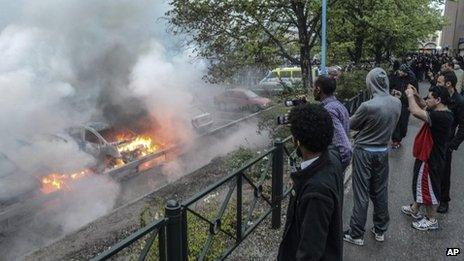Stockholm riots throw spotlight on Swedish inequality
- Published

Cars have been targeted for several nights in the suburb of Rinkeby
It's hard to discern a pattern in the violence that has wracked the Swedish capital Stockholm for five nights.
Rioting in the city's suburbs has raised the national debate about immigration, unemployment and social inequality.
The cars attacked in the violence are not high-end - not the BMWs and Porsches you might expect to see torched by class warriors - but the vans which ordinary people need to go about their business.
Schools, a station and a library have been attacked as well as a bank and a police station.
In the areas affected, local people said the motive of the youths making trouble was anger over joblessness.
Some said it was simply a matter of criminality and parents were to blame for not controlling their offspring better.
There was a widespread assertion that the violence was not motivated by Islamist ideology.
The police were not intervening aggressively. They told the 成人快手 that they had made a decision to liaise with community leaders - including in mosques - to try to calm the situation.
Fatal shooting
Despite the assertion, some local people said the police had been heavy-handed and there is clearly much anger at the shooting dead by police of an elderly man wielding a knife 10 days ago.
Many said there was a wider context of a growing gap between rich and poor in Sweden.
On OECD (Organisation for Economic Co-operation and Development) figures, Sweden has seen the biggest increase in inequality of any developed country over the past 25 years.
Immigrants and their descendants tend to congregate in areas such as Husby, the neighbourhood west of Stockholm where the violence started on Sunday.
About 80% of the 11,000 residents are either first- or second-generation immigrants.
Accordingly, this week's troubles have raised the volume of the debate in Sweden on immigration. About 15% of the population was born outside the country, the highest proportion in any of the Nordic countries.
The influx has come mostly from war-torn countries like Iraq, Somalia, the former Yugoslavia, Afghanistan and Syria. In 2012, Sweden accepted 44,000 asylum seekers, up by nearly 50% from a year earlier.
Sweden expects high immigration by refugees and other migrants for a few more years, then a drop - partly due to lower EU birth rates
Integration problems
The rise of the right-wing Sweden Democrats party, which has called for a curfew in response to the violence, has polarised Swedes. The polls show most people still favour immigration though the majority is diminishing.
The Swedish riots have similarities with those in London two years ago and in Paris in 2005 - an incident triggered widespread attacks on property, although there is no evidence of looting in Stockholm as there was in London.
A nursery school in Kista was among buildings set alight by youths
But there does seem to be a particular Swedish problem. The country had a reputation for generosity and an especially welcoming attitude but now something is clearly going wrong.
Aje Carlbom, a social anthropologist at Malmo University, said the government needed to accept that immigrants arriving without an adequate education were likely to remain unemployed.
He said: "Maybe a lot of money should be invested in second- and third-generation immigrants, to make sure they learn Swedish. The parents' generation, I think, unfortunately, is probably a lost cause in terms of integration."
The difficulty is that Sweden has always been perceived as a high-spending country, with generous provisions for education and social help.
It is not any more the Sweden we all thought we knew.
- Published23 May 2013
- Published22 May 2013
- Published9 June 2010